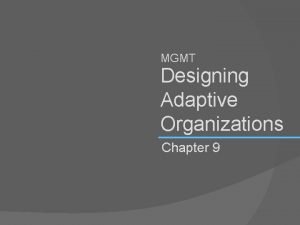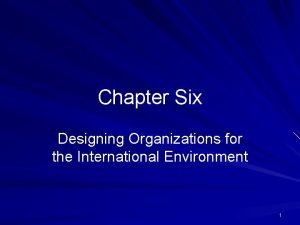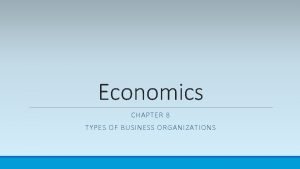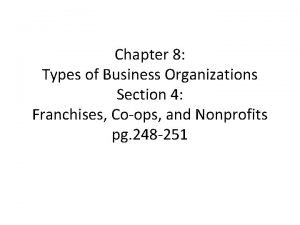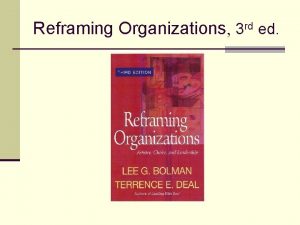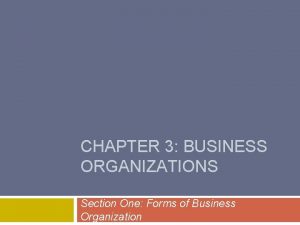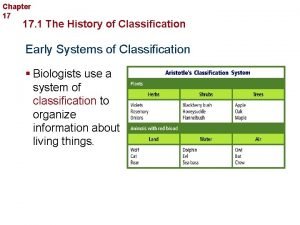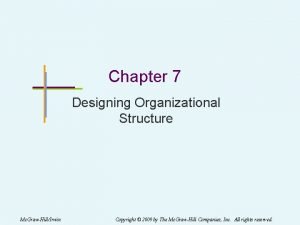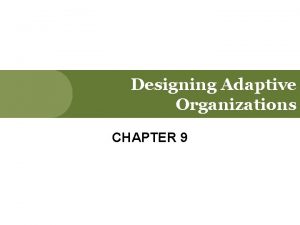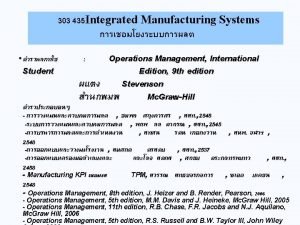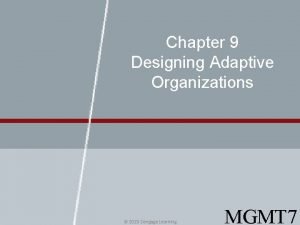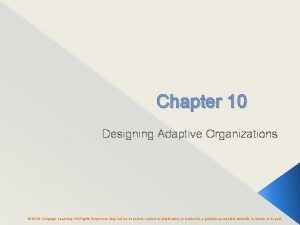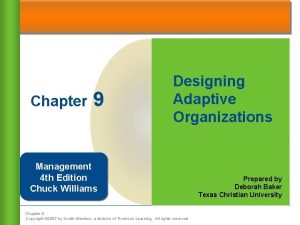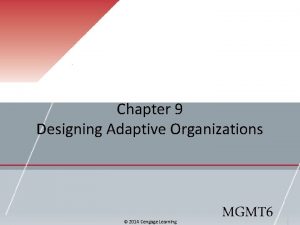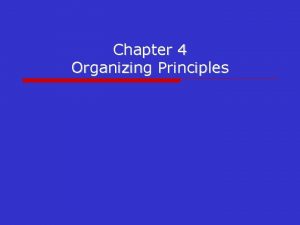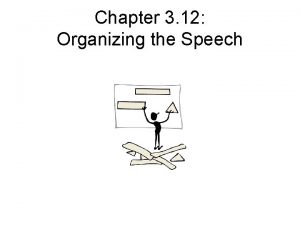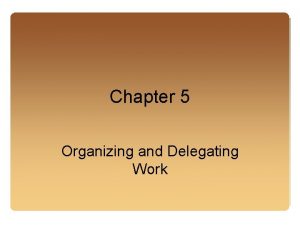Designing Adaptive Organizations CHAPTER 9 chapter 9 Organizing




















- Slides: 20

Designing Adaptive Organizations CHAPTER 9

chapter 9 Organizing • Organizing is the deployment of organizational resources to achieve strategic goals 2 Copyright © 2010 by South

chapter 9 Organizing The Vertical Structure • Organizing process leads to the creation of organization structure. • It is defined as (i)the set of formal tasks assigned to individuals and departments (ii)formal reporting relationships, including lines of authority, decision responsibility, number of levels and span of control (iii)the design of systems to ensure effective coordination of employees across departments 3 Copyright © 2010 by South

chapter 9 Organizing Concepts • Work Specialization – the division of tasks into individual jobs called division of labor • Chain of Command – a line of authority that links individuals and direct reports 4 Copyright © 2010 by South

chapter 9 Authority, Responsibility, and Delegation • The chain of command illustrates authority • Authority is the formal and legitimate right to make decisions and issues orders – Authority is vested in organizational positions, not people – Authority is accepted by subordinates – Authority flows down the vertical hierarchy • Responsibility is the duty to perform the task or activity assigned • Delegation is the process managers use to transfer authority and responsibility to others Copyright © 2010 by South 5

chapter 9 Line and Staff Authority • Line departments perform the tasks that reflect the organization’s primary goals – They work directly with customers/products • Staff departments are those departments that provide specialized skills in support of line departments – Legal, Human Resources, Marketing 6 Copyright © 2010 by South

chapter 9 Organizing Chart for a Water Bottling Plant 7 Copyright © 2010 by South

chapter 9 Span of Management • The number of employees reporting to a supervisor is span of management 8 Copyright © 2010 by South

Centralization and Decentralization chapter 9 Centralization means that decision authority is located near the top of the organization Decentralization means decision authority is pushed downward to lower organizational levels • Change and uncertainty are usually associated with decentralization • The amount of centralization or decentralization should fit the firm’s strategy • During crisis or risk of company failure, authority may be centralized 9 Copyright © 2010 by South

chapter 9 Departmentalization • Another characteristic of organization structure is departmentalization. • It is the basis for grouping positions into departments. • Five traditional approaches: – Functional – Divisional – Matrix • Innovative approaches: – Teams – Virtual Networks Copyright © 2010 by South 10

chapter 9 Approaches to Structural Design 11 Copyright © 2010 by South

chapter 9 Approaches to Structural Design 12 Copyright © 2010 by South

Vertical Functional Approach chapter 9 • Grouping into departments based on skills, expertise, work activities and resource use • Departmentalized by organizational resources – Accounting – Human resources – Engineering – Manufacturing 13 Copyright © 2010 by South

chapter 9 Divisional Approach • Departments are grouped based on outputs – Product structure, program structure, self-contained unit structure • Many large corporations have multiple divisions for different business lines • Organizations may assign division responsibility by geographic region or customer group 14 Copyright © 2010 by South

chapter 9 Matrix Approach • Combines aspects of both functional and divisional structures simultaneously • Improves coordination and information sharing • A key challenge is the dual lines of authority – Employees report to two supervisors 15 Copyright © 2010 by South

chapter 9 Dual-Authority Structure in a Matrix Organization 16 Copyright © 2010 by South

chapter 9 Team Approach • Teamwork is a growing trend • Teams allow organizations to delegate authority • Become flexible and competitive in global environment • Organizations may use cross-functional and/or permanent team strategies 17 Copyright © 2010 by South

chapter 9 The Virtual Network Approach • Extending the boundaries of collaboration beyond the organization – Subcontracting functions to other companies – Coordinate activities • Interconnected groups of companies – partnerships and collaborations 18 Copyright © 2010 by South

chapter 9 Network Approach to Departmentalization 19 Copyright © 2010 by South

chapter 9 The Need for Coordination ü Organizations grow and evolve ü Organizations need systems to process information and enable communication ü Coordination is the quality of collaboration across departments ü Coordination is required, regardless of the structure 20 Copyright © 2010 by South
 Matrix departmentalization
Matrix departmentalization Designing adaptive organizations
Designing adaptive organizations Teamsü
Teamsü Designing organizations for the international environment
Designing organizations for the international environment Chapter 8 types of business organizations
Chapter 8 types of business organizations Chapter 8 section 4 other organizations
Chapter 8 section 4 other organizations Chapter 8 business organizations
Chapter 8 business organizations Introduction to management and organizations
Introduction to management and organizations Reframing organizations chapter 3 summary
Reframing organizations chapter 3 summary Chapter 3 information systems organizations and strategy
Chapter 3 information systems organizations and strategy Chapter 3 business organizations
Chapter 3 business organizations Chapter 2 worksheet organizing and administering
Chapter 2 worksheet organizing and administering Organizing life's diversity
Organizing life's diversity Product
Product How to designing and managing service processes
How to designing and managing service processes Chapter 7 designing organizational structure
Chapter 7 designing organizational structure Chapter 7 designing organizational structure
Chapter 7 designing organizational structure Matched pair design
Matched pair design Designing and managing services ppt
Designing and managing services ppt Channel design decisions steps
Channel design decisions steps Chapter 4 designing studies
Chapter 4 designing studies
